Next Door To My Sign

For Sunday Scribblings and the prompt, "What's Your Sign?"
I took this photo a few minutes after midnight EST on June 29, 2007. The overexposed Moon is 98 percent of Full, which it will be on June 30. More detail is in the large view.
I've labeled Jupiter and Antares. Antares is the brightest star in the constellation Scorpius the Scorpion. That star is so named because it is the "rival of Mars" (from the Greek "anti-" (against) and "Ares" (Mars)). Slightly above and to the right of it is Sigma Scorpii. The star below and to the left of Antares is Tau Scorpii. The University of Illinois at Urbana-Champaign has a more complete labeled view of Scorpius here.
Out of frame to the right (to the west of Scorpius) is my sign, Libra. Out of frame to the left is Sagittarius, through which one can view the heart of our Milky Way galaxy....
My attention to the sky comes more from the astronomical than the astrological end. I did volunteer work in the planetarium field for five years, though I can't claim to recognize all or even most of the constellations. I never could find Camelopardalis the Giraffe, for example. But other constellations, Zodiacal and otherwise, are like old friends. When I took the photo above, standing barefoot on the driveway (a brave act, since we're into fire ant season, though I believe they were all asleep), the Summer Triangle was above and behind me: Cygnus the Swan and its brightest star Deneb; Lyra the Lyre and its brightest star Vega (pronounced "VEE-ga"); and Aquila the Eagle and its brightest star Altair. Inside the Triangle are smaller constellations: Sagitta the Arrow, for example. And one of my favorites, Delphinus the Dolphin, which looks like a small kite on a string.
The astrological Zodiac and the astronomical Zodiac are different. Astrology sets all its Zodiacal constellations at 30 degrees across, so that the planets pass through their houses with some regularity. But the actual pictures in the sky cover a broad range of distances. Virgo, the largest in the group, spans 1,294 square degrees -- almost three times the size of Aries, which covers 441 square degrees.
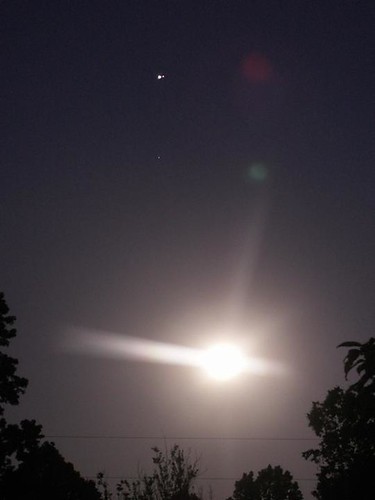
Large view
Libra, my sign, is a tough constellation to find. I took this shot back on May 12, 2006, when the Moon and Jupiter were both in Libra. At noon EDT that day, Jupiter (the bright dot near the top) was 5 degrees north of the Moon, in conjunction with it. That small dot just to the right of Jupiter is the second-brightest star in Libra, Zubenelgenubi.
According to our National Audubon Society Field Guide to the Night Sky, Zubenelgenubi is Arabic for "southern claw." Libra, made a separate constellation by the Romans, was once considered part of Scorpius.
As for the other side of Scorpius...
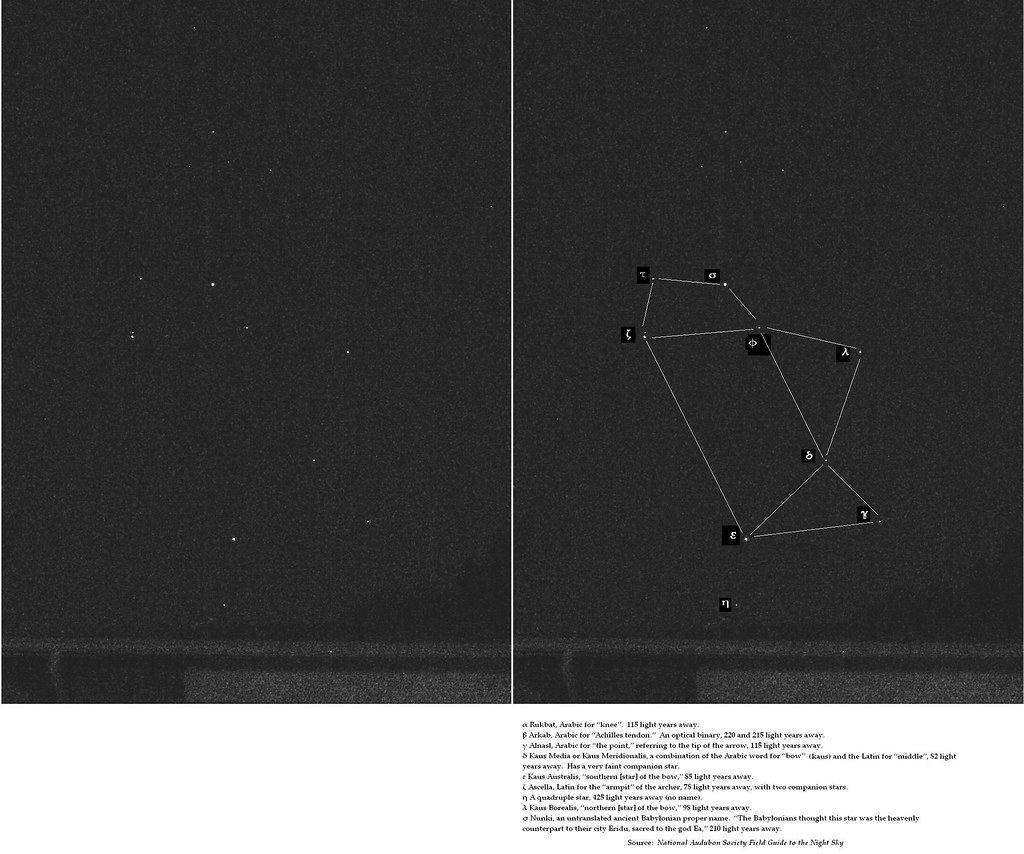
Large view
Sagittarius the Archer was setting over my garage when I took this shot on October 23, 2006. My camera is not geared toward astrophotography -- I aimed blind through my viewfinder, took the shot using my maximum available aperture (2.8) and exposure (4 seconds), and then used MS Photo Editor to increase brightness and contrast with some decrease in gamma to bring out the stars.
When you look at this constellation, you're also looking toward the center of the Milky Way.
According to the Audubon field guide, "This is a large constellation that was probably first associated with Nergal, the arrow-shooting god of war, by Sumerian peoples of the Euphrates Valley. It was known by the Greeks as the archer, and later came to be identified as a satyr or centaur. There has been much debate over just who Sagittarius is, though it is generally agreed that he is a centaur -- half man, half horse.... It is difficult to recognize a centaur here, but a modern asterism called the Teapot is relatively easy to find within the larger constellation....Sagittarius lies in the same direction of the sky as our galaxy's center, and so the band of the Milky Way is brightest here."
On occasion during my volunteer work I gave planetarium shows, mostly to school children, narrating live. The shows included star and constellation ID, and I once made a blooper as I pointed out Sagittarius. As the field guide says, Sagittarius is most easily recognizable as a teapot (the part I've labeled here), even though that's not what the ancients had in mind when they named it.
I told my audience, "This is Sagittarius, the Archer. Here is the handle, and here is the spout."
Elsewhere in the Zodiac...
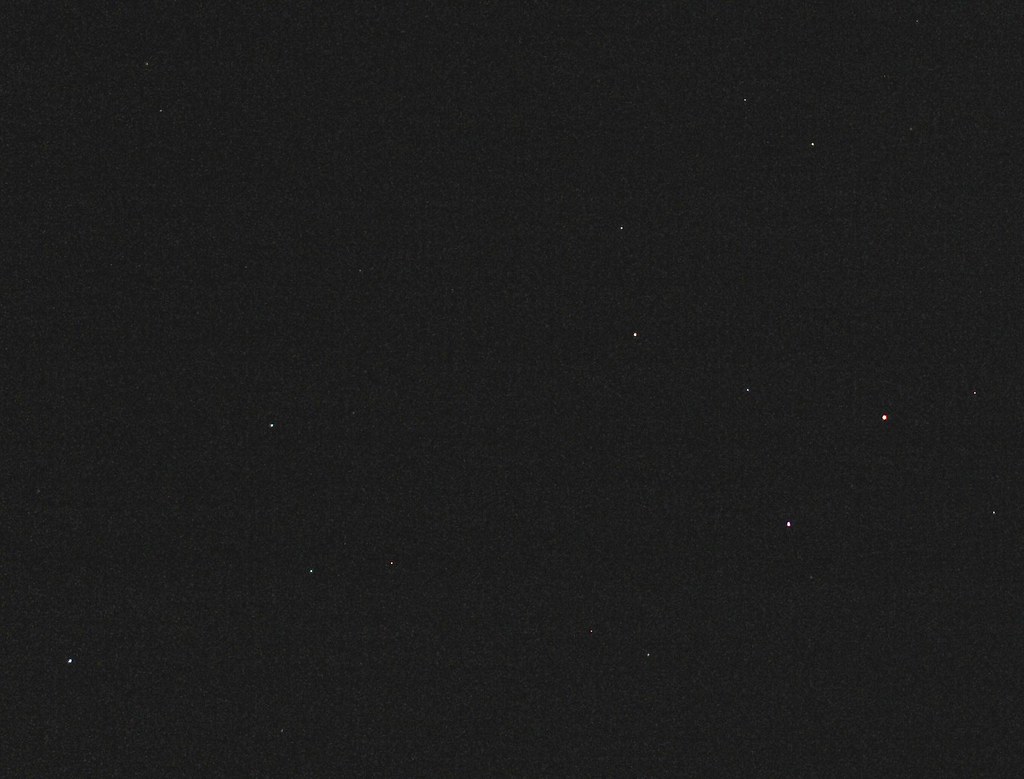
Large view
Saturn is still in Leo, as it was when I took this shot back on December 6, 2006. According to the Audubon field guide, Leo, the Lion, "was recognized as a lion by the ancient Sumerians, Babylonians, Persians, Syrians, Greeks, and Romans." It was a horse to the ancient Chinese, a puma (some believe) to the Incans. Around November 16 the Leonid meteor shower radiates from this constellation.
Here's my labelled version of that shot:
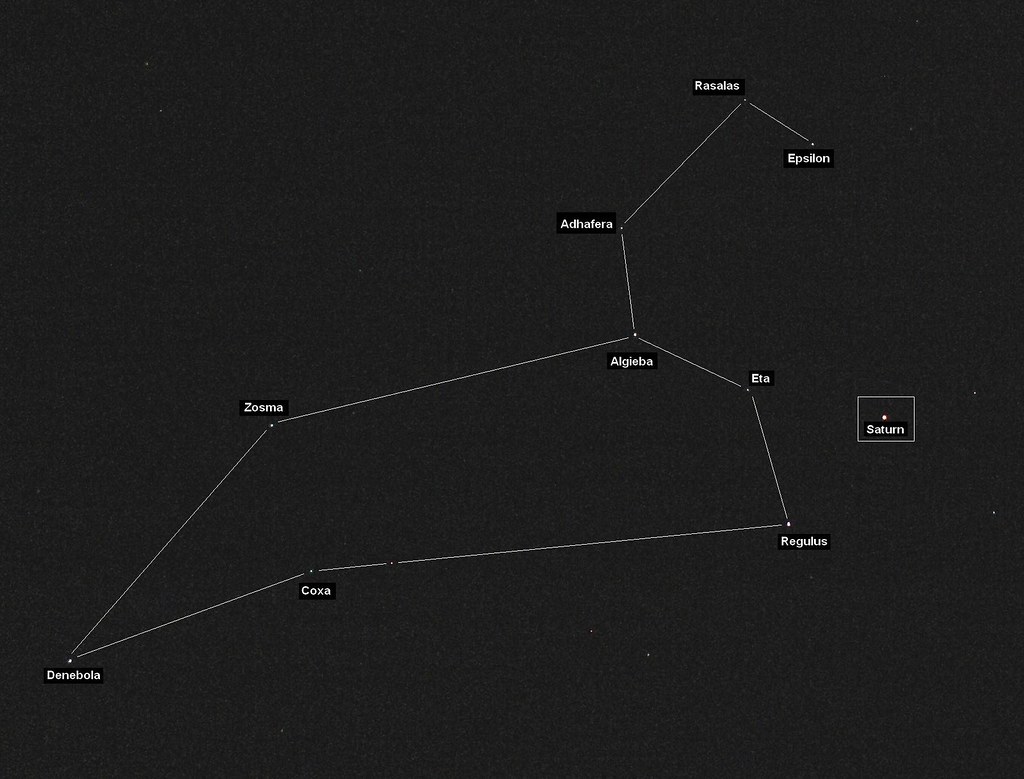
Large view
Nowadays Saturn is practically on top of Venus, so I'll have to see if I can get a good shot of them paired up.

Large view
Both the Hyades and Pleiades are in the Zodiacal constellation Taurus, the Bull. Both are star clusters, the Pleiades a group of young, still-forming stars. I took this photo on August 22, 2006. The Pleiades form what look like a tiny dipper at upper left. The Hyades are clustered around the stars near the bottom. The bright red star at the bottom is Taurus's brightest star, Aldebaran.
Says the Audubon field guide, "Taurus is assuredly one of the oldest constellations recognized, for it was among these stars that the Sun appeared at the beginning of spring between about 4000 and 1800 BC.... The bull, a symbol of strength and fertility, figures prominently in the mythology of nearly all early civilizations, from Sumer to India to northern Europe."
The field guide continues, "According to Greek mythology, the Hyades were the sisters of Hyas, a great hunter whose death they mourned....Zeus placed the nymphs in the sky in gratitude for their service and pity for their grief.... Taurus's better-known group of 'maidens' is the Pleiades, or Seven Sisters, a small but very noticeable cluster of stars on the bull's shoulder.
A labeled version, showing the names of the major objects, is here.
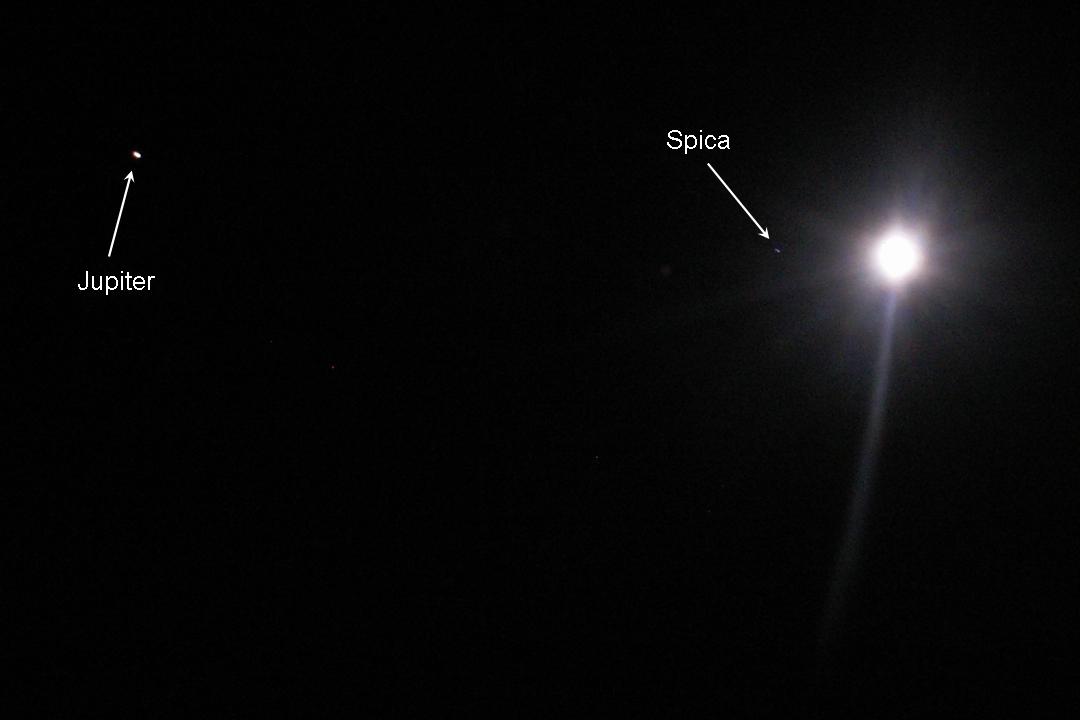
Large view
I took this shot on June 6, 2006, overexposing the Moon to show its proximity to Spica (the brighest star in the constellation Virgo) and Jupiter. Spica (pronounced "SPY-ka"), 262 light years away from us, is really two stars that orbit each other about every 4 days, with 3 other fainter components. Its name is Latin for "ear of wheat," the name actually going back to much more ancient times according to the University of Illinois at Urbana-Champaign department of astronomy.
You can use the Big Dipper to find Spica by using the mnemonic "Arc to Arcturus and speed to Spica." If you follow the curve of the Big Dipper's handle you will reach a bright reddish star. That's Arcturus, the brightest star in the constellation Bootes (pronounced "bow-OAT-ees," with the type of bow you tie). From there make a beeline to the next bright star; that's Spica.
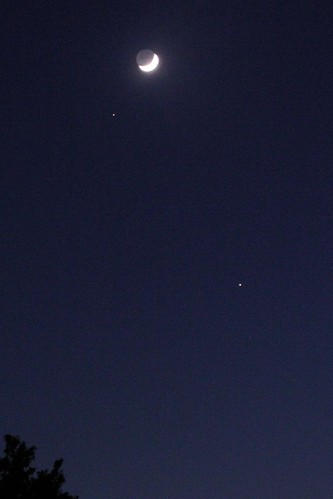
Large view
Almost exactly a year ago I took this photo, on June 28, 2006, showing the Moon, Mars (the bright dot just to its lower left), and Saturn (the brighter dot further away, just below middle right). This celestial trio was in Cancer. Here, the overexposed Moon (11% of full) is visible with Earthshine.
In Earthshine, the moon reflects light from two different sources. The thin crescent is light reflected from the sun. But the larger, dimmer illumination, in which one can see some hint of the mares ("seas"), is reflected from the Earth, which itself is reflecting sunlight onto the moon. Hence the term "Earthshine." That dimmer illuminated part of the moon is doubly-reflected light.
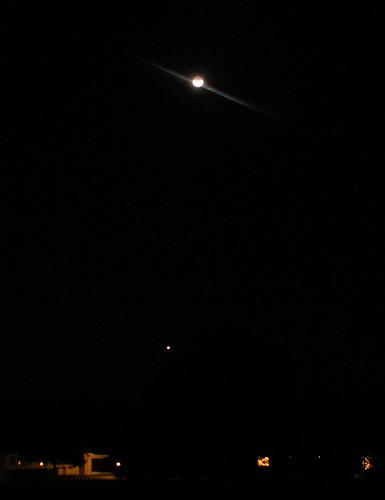
Large view
Here, the bright dot above the houses is the planet Venus, which joined a Moon three days past New in the constellation Pisces. I took this shot on the evening of February 20, 2007. On that day in 1962, John Glenn had become the first American to orbit the Earth.
Here's the crescent Moon from that same evening photographed with and without Earthshine:
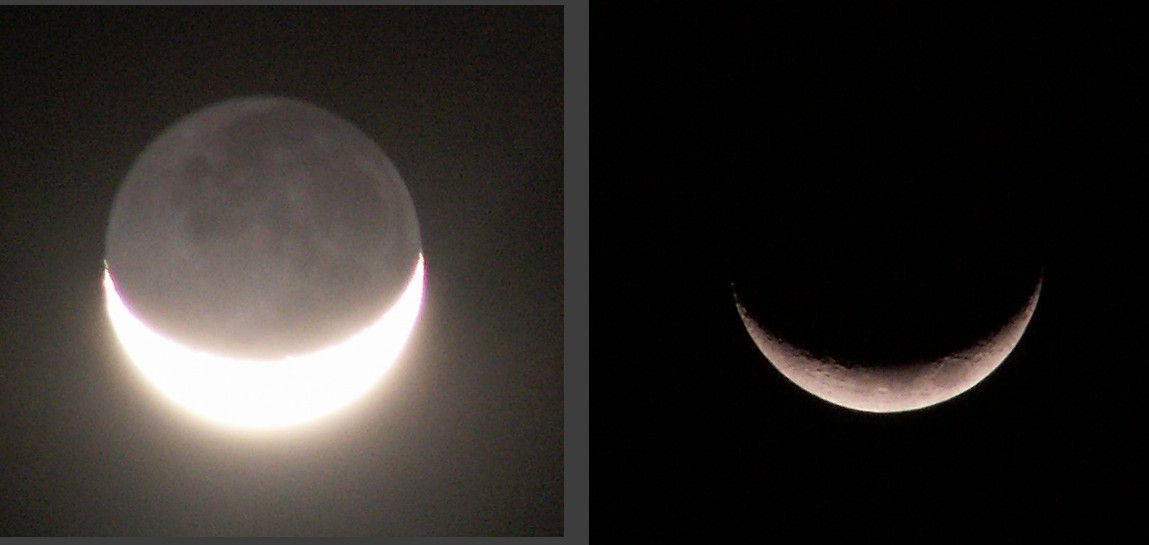
The left-hand shot showing Earthshine was a 4-second exposure at f/4.5. The right-hand shot was a 1/30-second exposure at f/8.
Back to tonight -- after I took the photo at top of the Moon in Scorpius with Jupiter and Antares, I focused solely on the Moon:
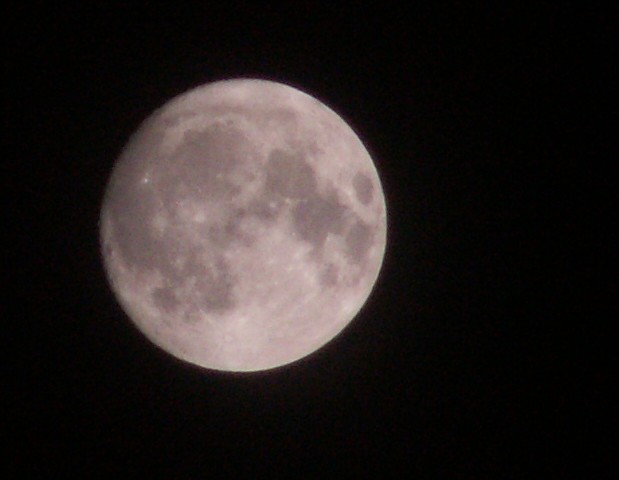
Non-Zodiacal constellations I've caught on pixel so far include Orion the Hunter, Canis Major the Great Dog, the Big Dipper portion of Ursa Major the Great Bear, and Cassiopeia the Queen.











3 Comments:
Beautiful. Sadly stars are hard to see from where I live.
Fascinating and interesting post. I learnt a lot here. Thanks.
Very cool pics! I only know a few constellations, despite having grown up where there was little light pollution.
If it is dark enough now, I can find the big and little dippers, orion, and the Pleiades. I remember looking at the Pleiades when we went skiing in the Rocky Mountains. With the thinner air and the lack of city lights we could always see more of "the sisters" there than at home.
Thanks for sharing.
Post a Comment
<< Home